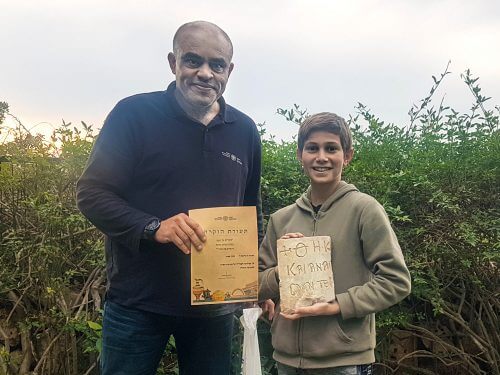13-year-old Stav Meir, who is studying at the School of Archeology with the Antiquities Authority, immediately realized that he had found an ancient find and reported the find. Illustrates well the extreme wealth of the wealthy of Caesarea about 1500 years ago"

13-year-old Stav Meir, a resident of Caesarea, went out a week ago with his father Zohar, his brother and cousins, to look for mushrooms in his area after the rains. Suddenly, he spotted a stone slab sticking out of the ground. He hastened to call his father and showed him the intriguing object, on which appeared an inscription in Greek. "I immediately recognized that it was something ancient," says Stav. "At the Caesarea Elementary School, I studied archeology with the Antiquities Authority, so I know how to recognize antiquities easily when I see them."
The excited Stav, who understood the importance of the report, hurried to inform the Antiquities Authority of the finding of the inscription, and an archaeologist came to collect it for research.
According to the archaeologist Dr. Petar Gendelman, a Caesarea researcher at the Antiquities Authority, "it is a burial inscription - a marble slab on which an inscription is engraved in Greek, and a cross appears at the top of it. On the plaque, which apparently indicated the location of the grave in the cemetery and the identity of the deceased - or the deceased, it was written - "Grave of... And of Anastasius, or Anastasia .....”. According to Dr. Gendelman, "Already in ancient times, Caesarea was a center of attraction for a strong population. The use of imported marble to create the tombstone that Stav discovered testifies to the affluent status of the buried person, and in general - to the customs, faith and wealth of the people of Caesarea during the Byzantine period. This inscription joins a large collection of burial inscriptions, which were discovered in the past around ancient Caesarea".
During the Byzantine period, the wealthy of the city of Caesarea built magnificent mansions in the suburbs of the city. These buildings gave their owners a quality of life, so that they enjoyed the rural character of the area on the one hand, and the proximity to the heart of the city on the other. To this day, sections of five luxurious mansions have been discovered in the area that spanned a large area, the most famous of which is the 'Bird Mosaic' building, whose area is estimated to be about one and a half dunams. Most of the floors in the parts of the complex, which was excavated and part of which is open to the public today, were made of colored mosaics.
According to Karam Said, archaeologist of the Haifa district at the Antiquities Authority, "The recent rainstorms that hit the country are bringing to the surface archaeological findings that were buried in the ground. The Antiquities Authority is happy and proud this fall for his good citizenship, and for the practical application of the content he - and his two brothers - learn with us in the classroom and in the field. Finding the inscription enriches the archaeological knowledge and the understanding of ancient Caesarea. We gave Stav a certificate of appreciation for his good citizenship, and we will come to his class for a special lesson that will deal with the address he found. We call on citizens to be partners in safeguarding the treasures of the land - report to us if you come across archaeological finds that surfaced during the rains."
